Report on a desmid flora excursion to the 'Schwemm' at Walchsee (Austria), June 2014
In the first week of June 2014, eight members of the Dutch desmid working group visited the peat area 'Schwemm' near the village of Walchsee, in Austria.
The Schwemm is a nature reserve* of about 60 ha representing various transitions between eutrophic swamps and oligotrophic bogs. This area has turned out to be one of the richest desmid sites in Austria, probably even in Europe. In total, some 340 taxa have been recorded, a number of them known to be very rare (Lenzenweger 2000, Šťastný, J. & Lenzenweger, R. (2008).
In particular the central part of the area, characterized by small oligo-mesotrophic pools with a vegetation of, among others, Scorpidium scorpioides, Utricularia intermedia, Menyanthes trifoliata, Rhynchospora fusca, Trichophorum alpinum and Scheuchzeria palustris harbours a fair number of remarkable desmid species. Despite the fact that the Schwemm was largely dried out in the period of our visit we succeeded in collecting quite a series of interesting samples.

Image © Alfred van Geest
Panorama view of the Schwemm
Some of the taxa that (today) are not occurring the Netherlands are discussed below.
Docidium undulatum
In Europe it is a rare species with a distinct atlantic-arctic distribution. Formerly known (as a rare species) from the Netherlands but not found again since the 1960's. In Lenzenweger's (2000) paper said to be a common species in the oligotrophic bogs region of the Schwemm but our group encountered only a very few specimens.
 Image © Alfred van Geest
Image © Alfred van Geest
Docidium undulatum
Euastrum ventricosum
Another rare species with a predominantly atlantic-arctic distribution. Formerly known from the Netherlands but not found again since the 1930's. Resembles somewhat the less rare species Euastrum crassum, so is possibly affiliated to that latter taxon. Rather common in the Schwemm.
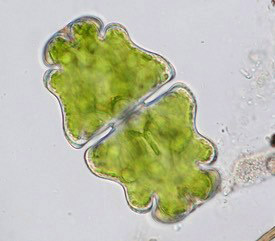
Image © Koos Meesters
Euastrum ventricosum
Euastrum intermedium
In its geographical distribution comparable with Euastrum ventricosum but even rarer. Unknown from the Netherlands. In the Schwemm only encountered in a few samples.
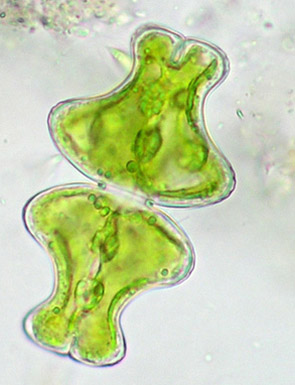 Image © Alfred van Geest
Image © Alfred van Geest
Euastrum intermedium
Micrasterias furcata
Resembles Micrasterias crux-melitensis but cells are more deeply incised. Rare species, formerly known from the Netherlands but not found again since the 1930's. In the Schwemm only encountered in the central part of the reserve.
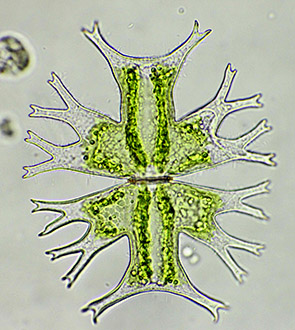 Image © Koos Meesters
Image © Koos Meesters
Micrasterias furcata
Cosmarium annulatum var. elegans
Also an atlantic-arctic taxon. Unknown from the Netherlands. Recorded from the Schwemm by Lenzenweger (2000) without any information about its abundance. In our group only observed by a single person, so obviously not a common species in that area.
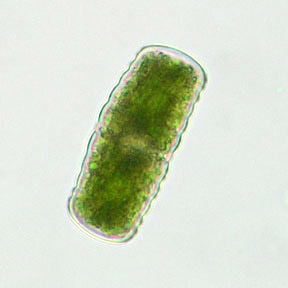 Image © Alfred van Geest
Image © Alfred van Geest
Cosmarium annulatum var. elegans
Cosmarium raciborskii
Rare species, mainly known from alpine regions. Unknown from the Netherlands. The cell wall of C. raciborskii is marked by irregularly outlined verrucae in the centre of which a pore is located. In the Schwemm occasionally encountered.
 Image © Koos Meesters
Image © Koos Meesters
Cosmarium raciborskii
Staurodesmus wandae
A very rare pecies, known from but a few European countries among which Austria, Recorded from the Schwemm by Lenzenweger (2003). Cell radiation may range from 4 to 10. Specimes collected from a small pool in the central part all were 4-radiate.
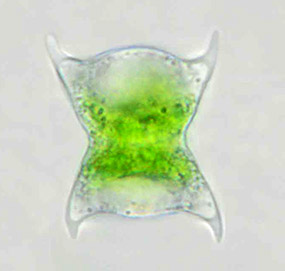 Image © Wil Leurs
Image © Wil Leurs
Staurodesmus wandae
Staurastrum monticulosum
An arctic-alpine species that, in its typical form, is unknown from the Netherlands. Found on a single site in the Schwemm.
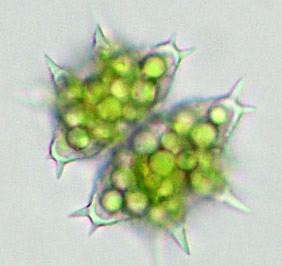 Image © Alfred van Geest
Image © Alfred van Geest
Staurastrum monticulosum
This large, usually 6-radiate Staurastrum species, most peculiar because of its splitted armlike processes, is mainly kown from atlantic-arctic regions. Unknown from the Netherlands. In Austria only known from the Schwemm, where it can be found in the most central part.
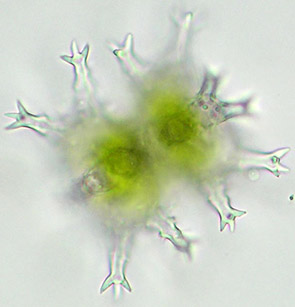 Image © Alfred van Geest
Image © Alfred van Geest
Staurastrum sexangulare (frontal view)
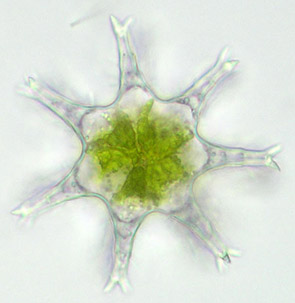 Image © Alfred van Geest
Image © Alfred van Geest
Staurastrum sexangulare (top view)
Staurastrum traunsteineri
This characteristic species, exclusively known from alpine regions in central Europe, was found in the Schwemm in a number of pools.
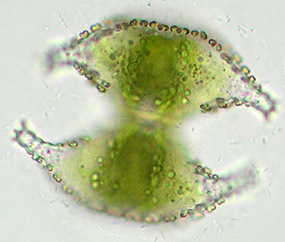 Image © Alfred van Geest
Image © Alfred van Geest
Staurastrum traunsteineri
Desmidium aptogonum var. ovale
As far as known, this biradiate Desmidium, described by Taylor 1935 from Newfoundland, was not reported for Europe before (but, most likely, it is identical to D. aptogonum var. ehrenbergii forma borgei described by Messikommer 1927 from Switzerland). By its very shallow cell sinus it might be confused with the likewise biradiate taxon Desmidium baileyi var. ovale. In the Schwemm, this variety was encountered in some pools in the central part.

Image © Koos Meesters
Desmidium aptogonum var. ovale (filament in frontal view)

Image © Koos Meesters
Desmidium aptogonum var. ovale (filament in lateral view)
Desmidium coarctatum var. cambricum
This nice Desmidium taxon, like the one discussed above a biradiate one, is most rare in Europe. It somewhat resembles the much commoner species Desmidium grevillei but has a relatively small cell apex (contact surface with neighbour cell) giving rise to a less massive impression of the cell chain.

Image © Alfred van Geest
Desmidium coarctatum var. cambricum
Desmidium pseudostreptonema
With respect to this species, in the Schwemm a somewhat deviating form was encountered characterized by highly reduced apical processes so that it is hardly to be recognized as a representative of the genus Desmidium, but rather resembles the taxon Spondylosium pulchrum. No doubt, the Schwemm record of Spondylosium lundellii in Lenzenweger (2000) refers to this reduced form of Desmidium pseudostreptonema. The taxon in question was pretty common in the samples collected by our group.

Image © Alfred van Geest
Desmidium pseudostreptonema (filament in frontal view)
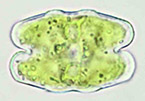 Image © Koos Meesters
Image © Koos Meesters
Desmidium pseudostreptonema (separate cell)
 Image © Koos Meesters
Image © Koos Meesters
Desmidium pseudostreptonema (filament in lateral view)
Conclusion
In conclusion, it can be stated that the extremely rich and peculiar Schwemm desmid flora described by Lenzenweger (2000) and Šťastný & Lenzenweger (2008) is still intact. We didn't find some extremely rare species recorded by Lenzenweger (2000), such as Euastrum bilobum and Euastrum attenuatum, but it has to be stressed that we examined only a limited number of samples. Even in this small collection we detected more than 300 taxa. Some of those, i.e., Spirotaenia diplohelica, Actinotaenium gelidum, Closterium pygmaeum, Eu. pseudoboldtii, Eu. verrucosum, Cosmarium holmiense var. integrum, C. luxuriosum, C. norimbergense, Xanthidium tenuissimum, Staurodesmus aristiferus, Std. validus var. subincus, Staurastrum diacanthum, St. myrdalense and Desmidium aptogonum var. ovale can be added to the total list of taxa known from this nature reserve. Noteworthy is the relatively high number of species with an atlantic-arctic distribution, Lenzenweger (2000) giving rise to render them the possible status of glacial relicts.
Amsterdam, July 2014,
Peter F.M. Coesel
References
Lenzenweger, R. (2000): Vorläufiges Ergebnis der Untersuchungen zur Zieralgenflora der Schwemm bei Walchsee in Nordtirol. — Ber. nat.-med. Verein Innsbruck 87: 41-66.
Lenzenweger, R. (2003): Desmidiaceenflora von Österreich. Teil 4. — Bibliotheca Phycologica 111.
Šťastný, J. & Lenzenweger, R. (2008): Ein Nachtrag zur Zieralgenflora (Desmidiales, Zygnematophyceae) der Wschwemm bei Walchsee in Nordtirol (Österreich). — Phyton (Horn, Austria) 48: 37-49.
* For authorization to enter the Schwemm: Schwemm at tiroler-schutzgebiete.at